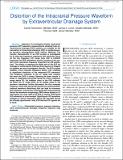| dc.contributor.author | Teichmann, Daniel | |
| dc.contributor.author | Lynch III, James Charles | |
| dc.contributor.author | Heldt, Thomas | |
| dc.date.accessioned | 2020-12-21T18:43:49Z | |
| dc.date.available | 2020-12-21T18:43:49Z | |
| dc.date.issued | 2020-11 | |
| dc.identifier.issn | 0018-9294 | |
| dc.identifier.issn | 1558-2531 | |
| dc.identifier.uri | https://hdl.handle.net/1721.1/128877 | |
| dc.description.abstract | CCBYNCND To investigate whether intracranial pressure (ICP) waveform measurements obtained from extraventricular drainage (EVD) systems are suitable for the calculation of intracranial elastance (ICE) or cerebrovascular pressure autoregulation (PAR) indices. Methods: The transfer characteristic of an EVD system is investigated by its step and frequency responses with particular focus on the low frequency (LF) range from 0.02 to 0.065\,Hz (important for PAR estimation) and the location of the system's first resonance frequency (important for ICE estimation). The effects of opening the distal end of the EVD for drainage of cerebrospinal fluid and the presence of trapped air bubbles are also investigated. Results: The EVD system exhibits a first resonant frequency below 4\,Hz, resulting in significant distortion of the measured ICP waveform. The frequency response in the LF range only remains flat when the EVD is closed. Opening the drain results in drops in magnitude and phase along the entire frequency range above DC. Air bubbles close to the EVD catheter tip affect the LF range while an air bubble close to the pressure transducer further decreases the first resonant frequency. Tests with actual ICP waveforms confirmed EVD-induced waveform distortions that can lead to erroneous ICE estimation. Conclusion: EVD-based ICP measurements distort the waveform morphology. PAR indices based on LF information are only valid if the EVD is closed. EVD-based ICE estimation is to be avoided. Significance: ICP waveform analyses to derive information about ICE and PAR should be critically questioned if only EVD derived ICP signals are at hand. | en_US |
| dc.language.iso | en | |
| dc.publisher | Institute of Electrical and Electronics Engineers (IEEE) | en_US |
| dc.relation.isversionof | http://dx.doi.org/10.1109/tbme.2020.3036283 | en_US |
| dc.rights | Creative Commons Attribution-NonCommercial-NoDerivs License | en_US |
| dc.rights.uri | http://creativecommons.org/licenses/by-nc-nd/4.0/ | en_US |
| dc.source | IEEE | en_US |
| dc.title | Distortion of the Intracranial Pressure Waveform by Extraventricular Drainage System | en_US |
| dc.type | Article | en_US |
| dc.identifier.citation | Teichmann, Daniel et al. "Distortion of the Intracranial Pressure Waveform by Extraventricular Drainage System." IEEE Transactions on Biomedical Engineering (November 2020): dx.doi.org/10.1109/tbme.2020.3036283 | en_US |
| dc.contributor.department | Massachusetts Institute of Technology. Department of Electrical Engineering and Computer Science | en_US |
| dc.contributor.department | Massachusetts Institute of Technology. Research Laboratory of Electronics | en_US |
| dc.relation.journal | IEEE Transactions on Biomedical Engineering | en_US |
| dc.eprint.version | Final published version | en_US |
| dc.type.uri | http://purl.org/eprint/type/JournalArticle | en_US |
| eprint.status | http://purl.org/eprint/status/PeerReviewed | en_US |
| dc.date.updated | 2020-12-17T18:56:39Z | |
| dspace.orderedauthors | Teichmann, D; Lynch, JC; Heldt, T | en_US |
| dspace.date.submission | 2020-12-17T18:56:48Z | |
| mit.license | PUBLISHER_CC | |
| mit.metadata.status | Complete | |
